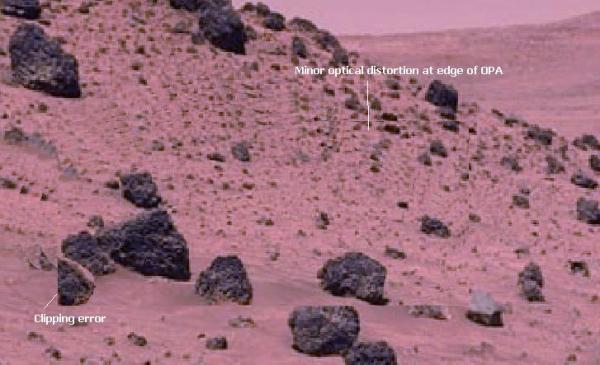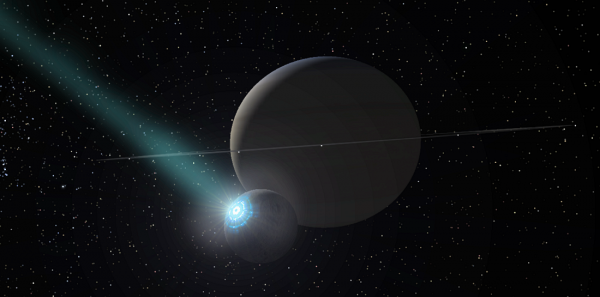BY LETTER
Optical Phased Arrays
Technology > Application > Weapons > Atmospheric Weapons
Technology > Application > Communications
Technology > Technology Type or Material > Drytech/Hylotech
Technology > Application > Everydaytech
Technology > Technology Levels > High Tech / Hitech
Technology > Application > Weapons > Space-Based Weapons
Technology > Application > Weapons > Stellar Weapons
Technology > Application > Weapons > Surface Weapons
Technology > Application > Communications
Technology > Technology Type or Material > Drytech/Hylotech
Technology > Application > Everydaytech
Technology > Technology Levels > High Tech / Hitech
Technology > Application > Weapons > Space-Based Weapons
Technology > Application > Weapons > Stellar Weapons
Technology > Application > Weapons > Surface Weapons
Image from Steve Bowers |
An Optical Phased Array (OPA) can be used as a thin outer layer on a wide variety of objects, which can then display images, be camouflaged, or even emit powerful collimated beams for a variety of purposes.
A phased array is a set of electrical oscillators hooked up to antennas, arranged on a surface and with a spacing of a moderate fraction of the wavelength of the radiation they emit. By controlling each of the oscillators independently, the amplitude, phase, and polarization of the electromagnetic field can be precisely controlled at the resonant oscillator frequency and its wavefronts can be shaped as required. A planar wave front propagates straight (neglecting diffraction), but the beam can have its direction shifted nearly instantly, and can be rapidly scanned back and forth if desired. Alternately, the beam can be made to converge, focused to a point in front of the array, or made to diverge away from the array's surface. This technology is often used in microwave frequencies as a powerful and rapid form of radar.
An oscillator that resonates at the frequency of visible light requires very small circuits only nanometers across distributed across a surface with appropriate spacing. Processing elements on a similar scale connect these emitters together and control their output. Using such an array it is possible to create complex visual displays which can mimic three dimensional objects. By emitting a diverging beam of light, it will act the same as a beam that came from a point source behind the OPA's surface. Someone seeing the light from this beam will see a point of light that appears to float behind the OPA. If the beam is converging, anyone seeing the light from the beam past the focal point will see a point of light hovering at the focal point. By displaying a continuous distribution of points that describe a surface it is possible to display an apparently solid object, either in front of, or apparently behind the OPA.
 Image from Steve Bowers | |
| Phased array optics can be used as camouflage objects, as shown here (a land-cruiser is concealed behind such an array, with only a few minor optical distortions to give away its location) | |
Such a display can project a 3 dimensional image at any location, even a distant object far behind the array. If oscillators of not just one frequency, but many, are used, it is possible to give the illusions a variety of colors and make them look lifelike. The OPA can now be used as a general purpose "holographic" display, replacing televisions, movies, and computer terminals. A layer of phased-array optical transmitters on the inside walls of a room or habitat could display an apparently limitless landscape and skyscape, with moving clouds, birds, aircraft, celestial objects and so on. This can often help to reduce feelings of claustrophobia in confined spaces.
There is an important limitation to this display that may not be immediately obvious. As long as it is only projecting images that appear to originate behind the display's surface, there is no problem. The OPA looks just like a window onto its displayed world. However, if it projects an image in front of it, an observer can only see the image if the light from the beam can enter your eye. This can only happen if the image is along the line of sight from the observer to the OPA's surface. Any part of the image that moves so that it is no longer directly in front of the OPA will cease to be visible. If the observer moves between the OPA and the image, you can see the light, but it will make no sense since the observer cannot focus it onto er retina.
To produce such complex waveforms and images sophisticated computer programs and ample processing power is required. Such images can be generated from scratch, or the OPA itself can be used to record the scene for re-transmission. The light which impinges on the OPA is absorbed by the nanoscale antennas and triggers currents in the oscillators, currents which can be measured and recorded. A complete record of the light coming into the OPA can be obtained, which can be played back by that OPA, or another, to produce a perfect fidelity recreation of the scene.
An OPA can make objects invisible. As an example, consider two flat OPA surfaces 30 cm apart facing away from each other. Each OPA is recording, the signal is processed to account for that extra 30 cm, and then played by the other to produce an image on its surface as if that extra 30 cm was simply empty space. An object placed between the two surfaces will disappear. Now, take the concept of the two OPA slabs, and wrap them around to form a closed surface, for instance a suit of clothing that covered the entire body. Anyone wearing that suit would become invisible. Although the eyes would need to be covered for complete invisibility, the wearer need not be blind - just have an OPA head's up display on the inside of the suit play back what is recorded from the outside.
Buildings with supports coated in OPA technology will appear to be floating in air - however they can be accessed by an (entirely invisible) elevator or even stairs. A mass of Utility Fog may have an external layer of OPA which will make it appear transparent. However this illusion of invisibility is not perfect. One minor limitation to this technique is that there must be a processing delay between when the signal is recorded and when it is played back. Even if this is so small that no one would ever notice it, it means that there is a phase difference between the light emitted from the edge of the OPA and that which travels through empty space. To a sensor with good enough resolution, this appears as a very faint discontinuity, a fringe around the wearer's silhouette. This effect is very hard for most people to detect without visual enhancements. While OPAs can work well in the near and mid infrared, the thermal emission of a room or body temperature OPA interferes with its ability to emit controlled light in the far infrared, making thermographic invisibility impossible. This assumes the OPA itself is at room temperature - if the OPA were cryogenically cooled, it would work in the far infrared just as well as at higher frequencies.
 Image from Steve Bowers | |
| An Optical Phased Array tranceiver on Tethys, a moon of Saturn (Solsys) | |
An OPA capable of emitting light at the same intensity as sunlight would produce approximately a kilowatt per square metre. A kilowatt focused to a diffraction-limited point is quite powerful and can be used for industrial welding, cutting, and drilling, but it is too weak for most weapon purposes. However a 30 m x 30 m array at 1 kW/m^2 can emit about a megawatt, which is quite sufficient to cause lethal flash burns while igniting clothing, or to vaporize holes through thin skinned vehicles given a dwell time of a few seconds. As the available intensity and/or surface area increases, so does the potential to use the OPA as a weapon.
Ultimately a phased array can be used as a long distance interplanetary or interstellar weapon. If an entire planet, moon, habitat or ISO is covered in phased array optics, the entire surface can produce a beam which can be focused on a distant point. The larger the object emitting the light, the longer the range, due to diffraction limitations. Covering an entire Dyson sphere or matrioshka brain creates an array with an extremely large aperture, which can be used to send a powerful beam an immense distance with considerable accuracy. A powerful beam of this sort could be used to accelerate spacecraft, communicate very large amounts of information, or even used as a weapon (see Nicoll-Dyson Beam)
Related Articles
- Beamed Energy Propulsion
- Chameleon Suit
- Chameleon Technology
- Hologram - Text by M. Alan Kazlev
An interference pattern that is encoded by laser beams and read by means of low-power laser beams. This interference pattern can reconstruct a three-dimensional image. An important property of a hologram is that the information is distributed throughout the hologram, so half a hologram retains the full picture, but at half the resolution. Biont memories have similar holistic properties. - Holovision - Text by M. Alan Kazlev
Media or information display device used for education and entertainment, as an alternative to both 2D on the one hand and DNI on the other. While crude versions were available as early as AT 67 (including compact portable models used with a head-mounted viewer for full-immersion audio/visual), full holovision had to await the development of sophisticated phased array optics in the early 3rd century, which give it the ability to project life-like three-dimensional images into the center of a room. - Janusuit
- Janusuit Countermeasures
- Laser
- Laser Sail, Maser Sail
- Laser Weapons
- Lightways, The
- Nicoll-Dyson Beams
- Perfect Optics
- Photon - Text by M. Alan Kazlev
The quantum unit of electromagnetic radiation, having some properties of a wave. For each wavelength, the photon has a different energy. - Photonics - Text by M. Alan Kazlev based on a list by Robert J. Hall
The study of the control of photons, especially for the transmission of information. Includes technology such as lasers, laser amplifiers, fiber optic cables, light-conducting buckytubes, light emitters, sensors and imaging systems of all sorts, charge-coupled devices, optical communication systems, holography, phased array optics, optical computers, and all types of optical data storage systems. - Yssa'arah
Appears in Topics
| Atmospheric Weapons | Communications | Drytech/Hylotech |
| Everydaytech | High Tech / Hitech | Space-Based Weapons |
| Stellar Weapons | Surface Weapons |
Development Notes
Text by Luke Campbell and Steve Bowers
Initially published on 15 November 2007.
More information about OPAs here
Phased Array Optics by Brian Wowk
Initially published on 15 November 2007.
More information about OPAs here
Phased Array Optics by Brian Wowk






